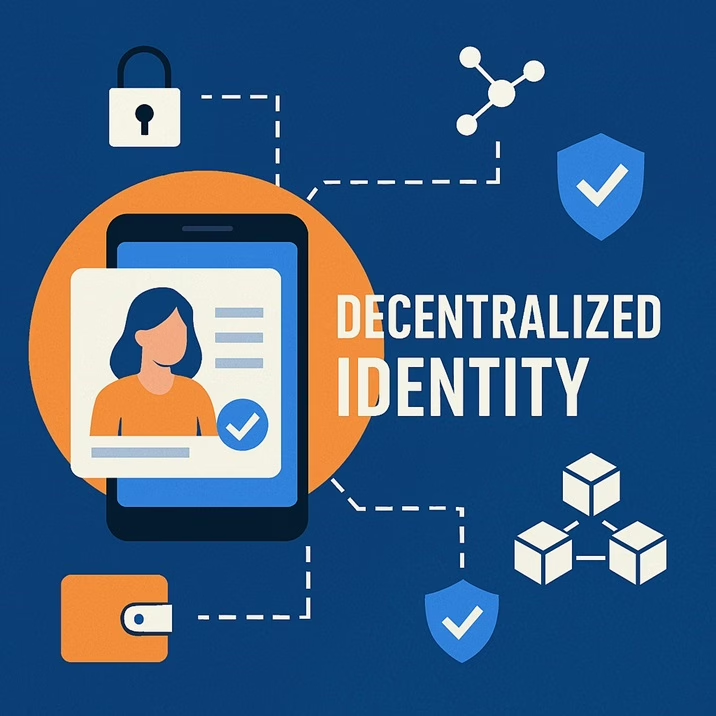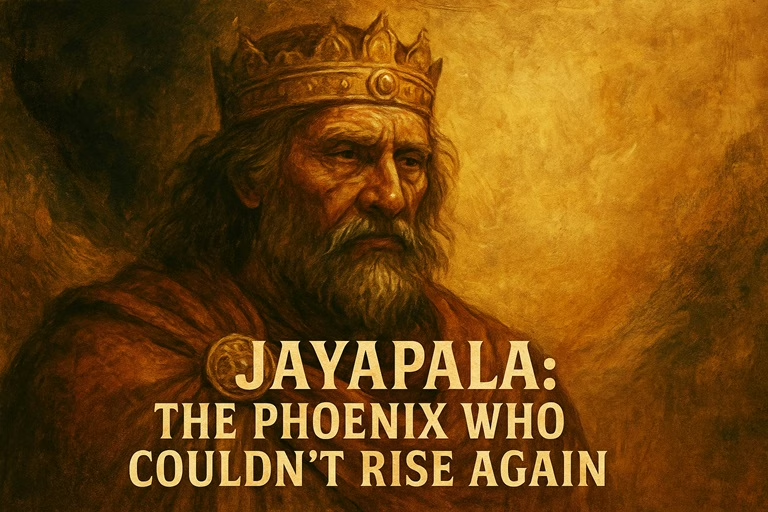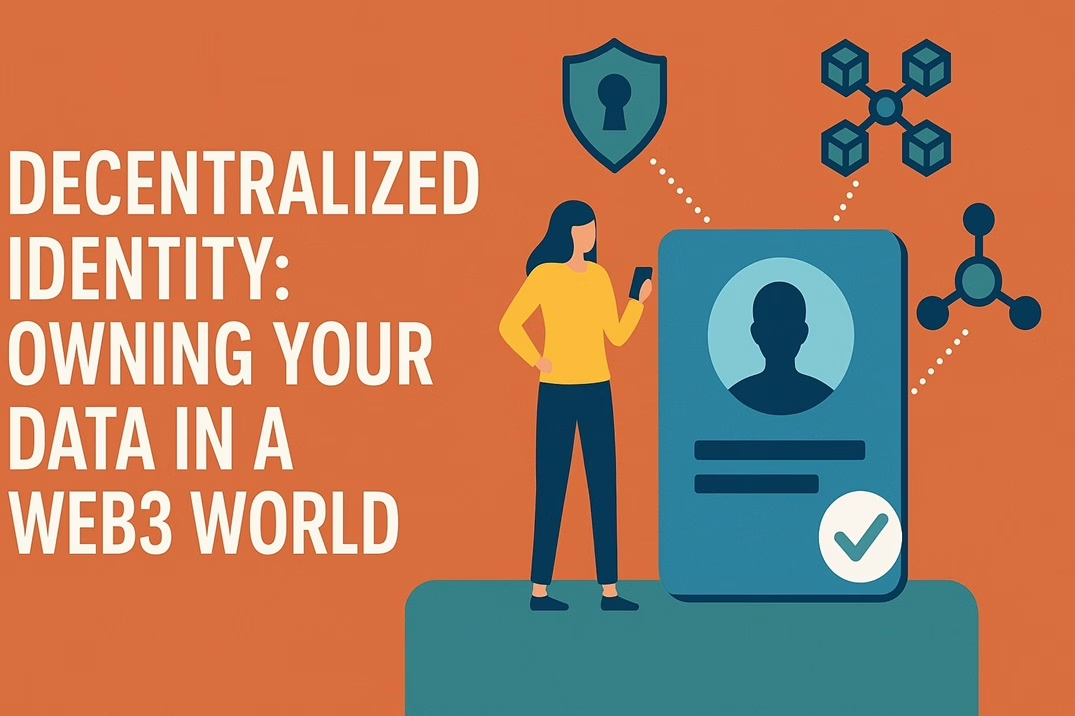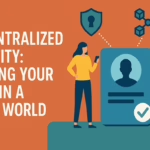Every time you log in with Facebook, show your driver’s license, or enter a password into yet another app, you’re essentially handing pieces of your identity to someone else to hold. Decentralized Identity (DID) offers a different path: what if you controlled your own digital identity, and only revealed the minimum needed to those who truly need to know? In a Web3 world emphasizing user control, decentralized identity puts you, and only you, in charge of your personal data. Let’s explore how this works and why it’s poised to change the way we prove things about ourselves online.
What is Decentralized Identity (SSI) in Simple Terms?
Decentralized identity – often used interchangeably with Self-Sovereign Identity (SSI) – is an approach where:
- You have an identity wallet (on your phone, for example) containing credentials about you (like “Alice is over 21” or “Alice has a Bachelor’s degree in Computer Science”).
- Those credentials are issued by trusted parties (maybe your government, your university, a previous employer) and are digitally signed so they can’t be forged.
- You decide whom to share which credential with, and you can even prove things without sharing the actual data (using clever cryptography like zero-knowledge proofs).
Importantly, no central identity provider (like Google or DMV database) is needed to vouch for you every time. The credentials are verified via blockchain or decentralized networks if needed, to confirm that they’re legitimate and unaltered. But your personal data isn’t sitting on a blockchain – it’s with you.
Think of it like a digital wallet replacing your fat leather wallet:
- Today’s wallet holds an ID card, some membership cards, etc. You show your ID to bouncer to prove age (revealing name, birth date, address – more info than needed).
- A DID/SSI wallet would let you send a cryptographic proof from your device to the bar’s device that simply says “✔ over 21, issued by State of X” without disclosing your name or exact birthdate.
- The bar’s device can verify that proof by checking the issuer’s public key on a blockchain registry or similar (to ensure the State did sign it), and voila – you’re in, and your privacy is preserved. The bar doesn’t get to collect your home address from your ID or any scannable data to sell.
In essence, you own your data. This addresses a huge problem: we routinely overshare personal info because of how identity works now (showing a full ID, repeating social security numbers, etc.), and that data lives in countless databases prone to breaches (how many times has some store or credit bureau leaked millions of SSNs? Too many).
Key Components of Decentralized Identity
- Decentralized Identifiers (DIDs): These are like your user IDs but not tied to one central service. A DID might look like “did:example:123456789abcdefghi”. It’s registered in a way that it can be resolved to get necessary info (like public keys to verify your proofs) without a central authority. W3C has a standard for DIDs.
- Verifiable Credentials (VCs): These are the digital claims issued to you. Example: “Employee of TechCorp, role: Engineer” signed by TechCorp’s key. They’re tamper-evident and can be checked against issuer’s DID.
- Blockchain as a Trust Anchor: The system often uses a blockchain to store the public keys of issuers (so verifiers can trust a credential came from who it says). For instance, a university’s DID and public key might be on a public or permissioned ledger. It doesn’t store your diploma itself, just the info needed to verify a diploma credential you present.
- Identity Wallet Apps: User-friendly apps (on mobile or desktop) that manage your decentralized identity and credentials, letting you receive new credentials and present proofs. They also handle keys under the hood – possibly with backup mechanisms (some use social recovery or cloud backup of encrypted keys, because pure self-management of keys can be risky if people lose them).
- Selective Disclosure & Zero-Knowledge Proofs: These allow you to share just what’s necessary. For example, from a full ID credential, you can generate a proof “I am older than 18” without revealing birth date – the math proves the statement true using the issuer’s signature, but doesn’t reveal extra data.

Benefits: Owning and Protecting Your Data
- Privacy: You reveal less personal data to companies. In a world of constant data breaches, this is huge. If a service never collects your date of birth (just got a yes/no that you’re adult), there’s nothing of that sort to leak or misuse. Also reduces profiling – e.g., if using a credential-based login, a site doesn’t get to scoop up a ton of attributes about you from a social login or track you across services easily.
- Security: Fewer honey pots of identity data exist. Also, since verification can be cryptographic, it’s harder to forge identities. For instance, to impersonate someone’s credential, you’d need to steal their private key – which is much tougher than, say, fabricating a fake paper ID or guessing someone’s password or bypassing weak knowledge-based verification (“What’s your mother’s maiden name?”).
- User Control & Convenience: Instead of signing up filling long forms (and trusting that service to safely store that info), you could just click “share my verified email and age credential” from your wallet. Instant account, more trust on both sides. If your info changes (like you get married and new last name), you update with the credential issuer (government etc.) and you hold the new credential – you’re not at the mercy of dozens of services to update one by one. It flips the model: you update it once and present the up-to-date credential to whoever needs it.
- Interoperability: Credentials can be universally recognized if standards are followed. Instead of each organization issuing their own ID card or login, they could issue you a VC that you keep. Your university degree, your driver’s license, your company ID could all live in one wallet. It’s like having one master key instead of a keychain with 50 keys.
- No Central Overlord: In a Web3 context, this aligns with the ethos – no single company like Google controls your identity such that if Google locks your account, you’re locked out of half the web. With DID, as long as you maintain your keys, you can prove who you are. Even if an issuer ceases (e.g., a company that employed you shuts down, but the credential they gave you can still be verified via their DID on blockchain if that remains or via a community governance that might maintain legacy records).
Real World Progress
This isn’t just theory. Real pilots are in motion:
- Microsoft’s ION (on Bitcoin) and Affinity/Trinsic etc. – big players working on decentralized identity solutions. Microsoft’s ION network is an open, public DID system anchored to Bitcoin’s blockchain, intended to handle lots of DIDs in a decentralized way.
- Government projects: The EU launched EBSI (European Blockchain Services Infrastructure) partly to support cross-border decentralized identity for citizens, so an Italian’s academic credential can be verified in Finland with no language or system barrier.
- Corporate credentials: Some companies issue work credentials via SSI now, which employees can reuse as portable resumes. E.g., Deloitte issues digital credentials to employees for qualifications.
- Humanitarian: ID2020 alliance (involving Microsoft, Accenture, etc.) works on giving refugees a portable digital identity since they often lack national IDs. Blockchain-based identity has been tested to help prove one’s history to get services.
- Web logins: Initiatives like Sign-In with Ethereum allow logging into web services by proving control of an Ethereum address (which could be a DID). Not full SSI with attributes, but a step towards decentralized login.
It’s early, but standards (W3C DID and Verifiable Credentials) are fairly mature. Now it’s about adoption and building user-friendly experiences.
Challenges and Considerations
To give a balanced view:
- Key Management: The Achilles heel of self-sovereignty. People are historically bad at not losing keys (physical or digital). If someone loses their identity wallet or keys, how to recover? Solutions include social recovery (appointing trusted contacts to help restore) or custodial agents (a service could hold an encrypted backup). Some fear self-managed identity could exclude less tech-savvy folks or lead to disasters if not done carefully. Systems must incorporate robust recovery methods, or many will prefer old centralized safety nets.
- Privacy vs Public Verifiability: Storing anything on a blockchain can be public; in SSI usually personal data isn’t on-chain, just issuer public keys and perhaps revocation registries (to check if a credential was revoked). But if not designed carefully, one could leave traces – e.g., if every time you use a credential it checks a public revocation list, could someone correlate your usage? Techniques like using pairwise DIDs (different identifier per connection) and ZK proofs help reduce correlation.
- Adoption by institutions: For this to work widely, governments, banks, schools etc. need to issue and accept these credentials. That’s a lot of stakeholders. Many might wait for more proven ROI or mandate (the EU might mandate interoperability by law, which could jumpstart things). There’s a network effect: SSI is most useful when many parties use it. It might start in niches (e.g., travel – using digital passport and health certificates – some trials have been done, like IATA’s travel pass).
- Security and Trust: We must trust issuers to issue accurate credentials. If a hacker breaches a university and issues themselves a degree credential, what then? Likely issuers will have to secure their signing keys extremely well. The beauty though is any bogus issuance could be quickly traced to the issuer – so trust is still present, just more transparent and limited (you trust the issuer in their domain, not an all-powerful central authority for everything). If an issuer is compromised, they’d revoke credentials and update keys on ledger (the user’s wallet would likely indicate if a credential’s issuer key is superseded or if it was revoked).
- User Consent and Control: Systems must ensure the user truly controls sharing. It should be as simple as granting or denying via app prompt. Also, not everyone will want to directly hold this – maybe managed solutions will emerge (like identity wallets provided by a bank or ID provider but still under your ultimate control with ability to move).
Despite these challenges, the momentum is there because current identity systems are clearly flawed: too much friction (passwords, KYC processes), too much data exposure, and too many breaches (just think how Equifax leak put half of US at risk of identity theft).
Ownership of your data in decentralized identity doesn’t just mean possession, it means agency: you decide who gets what and you can take it back (by revoking a permission or using an ephemeral proof that doesn’t live on their servers forever). It aligns with data protection laws like GDPR’s principle of data minimization and explicit consent.
In a Web3 world, where you might interact pseudonymously across decentralized apps, DIDs can help bridge trust gaps (maybe you stay pseudonymous but show credentials like “Certified Doctor” or “18+” or “No criminal record” depending on context, all without revealing true name – enabling trust but preserving anonymity when desired). That’s quite revolutionary for online interactions, enabling verified personas that aren’t tethered to your offline identity unless you want them to be.
Conclusion: Decentralized identity might not be as flashy as NFTs or metaverse, but it’s arguably one of the most impactful shifts quietly happening. It promises a future where you own your data and identity like you own your home, and lend out the keys only when necessary and on your terms. It puts privacy and control back in user hands – something we desperately need in an era when personal data is often abused. There’s work to do and adoption to win, but I foresee a day when explaining how we used to give up so much personal info or juggle hundreds of logins will sound as archaic as dial-up modems. The move to own your data is part of making the web more human-centric again, and that’s a future worth building toward.
Also Read – PEAS Framework













